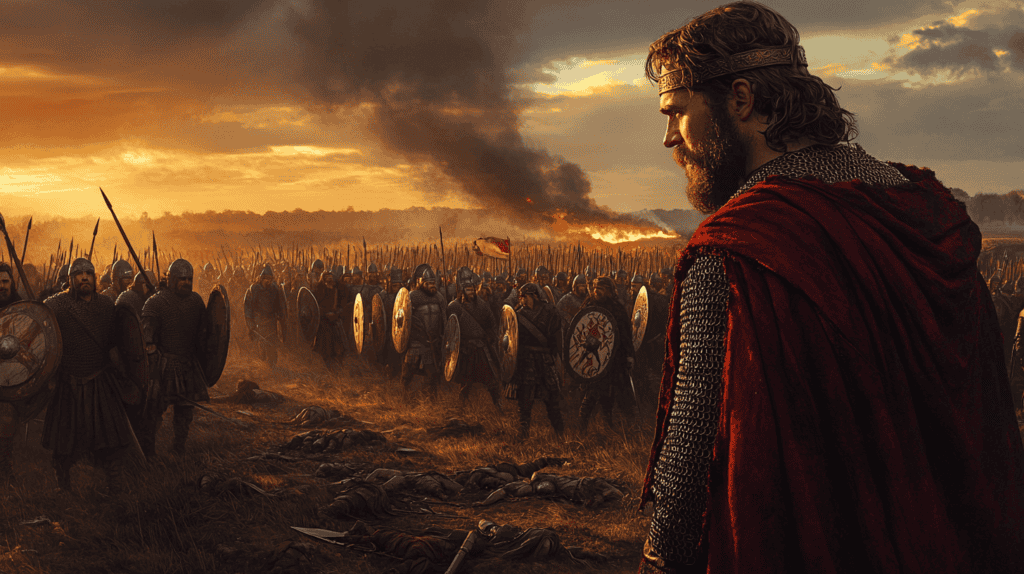
In the summer of 909, King Edward of Wessex launched a daring raid into the heart of the Danelaw. His target: the remains of Saint Oswald, a 7th-century English king martyred in battle against pagans. This holy relic, housed in Bardney Abbey, Lincolnshire, was more than a religious symbol; it was a potent emblem of English unity in the face of Viking occupation.
For five weeks, Edward’s combined force of Mercians and West Saxons ravaged the countryside, finally seizing their prize and transferring it to St Oswald’s Priory in Gloucester. This audacious move was a clear provocation to the Viking rulers of York, who responded with a retaliatory strike deep into Mercian territory.
Edward, displaying the tactical acumen that would become his hallmark, ordered his forces to intercept the retreating Vikings. The two armies clashed in August 910 at Tettenhall, Staffordshire. The battle was a decisive victory for the English, with the Anglo-Saxon Chronicle reporting that Edward’s forces “put the [Viking] army to flight and killed many thousands of its men”. Among the fallen were two Danish kings, Eowils and Halfdan, along with several earls and chieftains.

This crushing defeat significantly weakened the Viking threat from York, isolating the southern Danelaw and setting the stage for Edward’s future campaigns. The victory at Tettenhall marked a turning point in the struggle for control of England, shifting the balance of power decisively in favor of the Anglo-Saxons.
The Succession of Aethelflaed
In 911, Aethelred of Mercia passed away, leaving no male heir. His wife, Aethelflaed, Edward’s sister, succeeded him as ‘Lady of the Mercians’. This transition was smooth, as Aethelflaed had already been acting as co-ruler due to her husband’s declining health. Edward of Wessex, recognizing the strategic importance of maintaining a strong alliance with Mercia, supported his sister’s succession.

The Danelaw Campaign
With Aethelflaed secure in Mercia, Edward turned his attention to the Danelaw. The siblings agreed on a division of military responsibilities: Edward would focus on East Anglia and the Southeast Midlands, while Aethelflaed would defend against threats from Wales and the Norse-Irish in the northwest.
Edward’s strategy centered on the construction and fortification of burhs (fortified towns) along his borders. These served as both defensive strongholds and launching points for offensive operations. From 912 to 914, he established new burhs at Hertford, Buckingham, Witham, and Maldon, steadily pushing into Viking-held territory.

The Viking response was largely defensive. Many leaders, sensing the shifting tide, chose to submit peacefully rather than face Edward’s growing power. Thurkytel, Jarl of Bedford, for instance, surrendered in 915, allowing Edward to fortify the town.
The campaign reached its crescendo in 917. A coalition of Viking armies launched a series of assaults on Edward’s border burhs, including Towcester, Bedford, Maldon, and Wigmore. All were repulsed by the defenders. Seizing the initiative, Edward went on the offensive, capturing the Danish strongholds of Tempsford and Colchester. The brutal siege of Tempsford proved particularly decisive. Edward’s army stormed the burh, overwhelming its defenses. In the bloody slaughter that followed, several high-ranking Danish leaders fell, including King Guthrum II of East Anglia and Jarls Toglos and Manna
By year’s end, several leaders in the southern Danelaw had sued for peace, swearing oaths of loyalty to Edward. The campaign, later praised by historian Sir Frank Stenton as “one of the best-sustained and most decisive campaigns in the whole of the Dark Ages“, had effectively broken Viking power in East Anglia, Essex, and Northamptonshire.

Mercia and the North
While Edward campaigned in the east, his sister Aethelflaed was equally successful in the west. Her military strategy focused on fortifying Mercia through the construction of burhs, fortified settlements that served as defensive strongholds and bases for offensive operations. She established a network of these fortifications, including Bridgnorth, Tamworth, Stafford, Warwick, Chirbury, and Runcorn. One of Aethelflaed’s most significant military achievements occurred in 916 when she led a retaliatory campaign into Wales. This was in response to the murder of a Mercian abbot and his retinue in Brycheiniog. Aethelflaed’s forces ravaged the kingdom, demonstrating her ability to project power beyond Mercia’s borders.
In 917, Aethelflaed achieved her greatest triumph by personally leading an army to capture Derby, one of the Five Boroughs of the Danelaw. This victory marked a turning point in the reconquest of Danish-held territories. Despite suffering heavy casualties, including four of her senior thegns, Aethelflaed’s forces successfully stormed the fort. The following year, Aethelflaed continued her campaign, marching on Leicester. Her army’s approach was so formidable that the Danish settlers surrendered without a fight. This victory further weakened Danish control in the Midlands and paved the way for the eventual reconquest of the Danelaw. By 918, she was even negotiating to bring York under her control.

However, Aethelflaed’s sudden death on June 12, 918, at Tamworth, threatened to upset the delicate balance of power. Her daughter, Aelfwynn, was initially supported as Mercia’s new ruler, but by December, Edward had taken direct control of Mercia, deposing his niece. While the Mercian nobility appears to have accepted this transition, some, like the chronicler Henry of Huntingdon, questioned the justice of Edward’s actions.
With Mercia under his control, Edward received the submission of several Welsh kings and resumed his eastern campaign, capturing Stamford and Nottingham. However, a new threat emerged in the north with the arrival of Ragnall, a Viking leader who established himself as King of York in 918.
To counter this threat, Edward adopted his sister’s strategy of northern alliances and border fortifications. He built new burhs at Bakewell, Manchester, and Thelwall, and in 920, convened a diplomatic gathering at Bakewell. The Anglo-Saxon Chronicle describes this meeting as a general submission to Edward by the northern rulers, including the kings of Scotland and Strathclyde, as well as Ragnall himself. However, this was likely an overstatement, and the agreement was probably more of a peace treaty than a submission.

The Final Years
Despite his successes, Edward faced internal challenges toward the end of his reign. In 924, Chester revolted against his rule, forcing him to suppress the rebellion personally. Shortly after, on July 17, 924, Edward died at his estate in Farndon, Cheshire.
Edward the Elder’s reign marked a crucial turning point in English history. Through his, and his sister’s military campaigns and strategic alliances, he laid the groundwork for the unification of England, a process completed by his son Aethelstan in 927. Edward’s legacy extended beyond England’s borders through the marriages of his daughters into European royal families, further enhancing the kingdom’s international standing.
More than just a successful warrior, Edward the Elder was a skilled strategist and statesman who transformed the political landscape of dark age England. His reign set the stage for the emergence of a unified English kingdom, a legacy that would endure for centuries to come.




